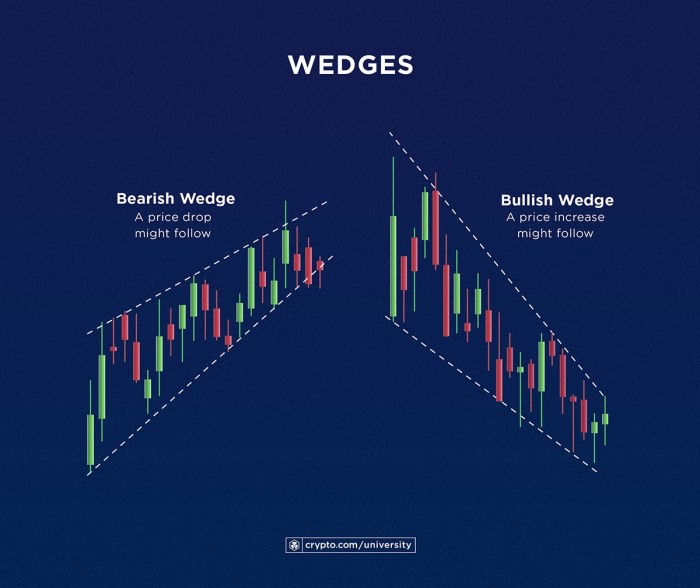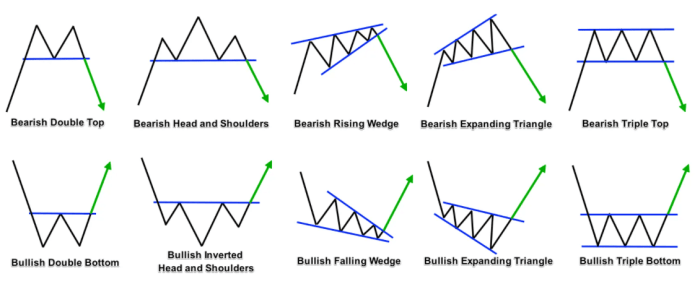How to Read Crypto Market Charts Effectively sets the stage for diving deep into the world of cryptocurrency trading charts, offering insights and tips to navigate this complex landscape with confidence and skill.
Get ready to unlock the secrets of interpreting crypto market charts like a pro.
Understanding Crypto Market Charts

Cryptocurrency market charts are essential tools for traders and investors to analyze price movements, trends, and make informed decisions. There are several types of crypto market charts commonly used, each providing unique insights into the market.
Types of Crypto Market Charts
- Line Charts: Line charts display the closing prices of a cryptocurrency over a specific period. They are simple and easy to read, showing the overall trend.
- Candlestick Charts: Candlestick charts provide more detailed information, including opening and closing prices, as well as high and low prices within a specific time frame. Traders use candlestick patterns to predict future price movements.
- Bar Charts: Bar charts display the same information as candlestick charts but in a different visual format. They show opening, closing, high, and low prices for a specific time period.
Key Elements in a Crypto Market Chart
- X-Axis: Represents time, showing the chronological order of price movements.
- Y-Axis: Represents the price level of the cryptocurrency being analyzed.
- Volume: Indicates the total amount of trading activity for a specific period, showing the liquidity of the market.
- Indicators: Technical indicators like moving averages, RSI, MACD, etc., help traders analyze trends and make predictions.
Popular Platforms for Viewing Crypto Market Charts
- CoinGecko: A popular platform that provides comprehensive cryptocurrency data, including interactive charts and market insights.
- TradingView: A widely used tool by traders for analyzing financial markets, offering customizable charts with a wide range of technical indicators.
- CoinMarketCap: Another popular platform that offers market data, charts, and insights for a wide range of cryptocurrencies.
Reading Candlestick Charts
Candlestick charts are a popular tool used by traders to analyze price movements in the crypto market. Each candlestick represents a specific time period and shows the opening, closing, high, and low prices during that time frame. By understanding how to read candlestick charts effectively, traders can gain valuable insights into market trends and make informed trading decisions.
Significance of Different Candlestick Patterns
- Candlestick patterns such as doji, hammer, and engulfing patterns can provide valuable information about market sentiment and potential price reversals.
- Patterns like bullish engulfing and bearish engulfing can signal a potential shift in market direction, indicating buying or selling pressure.
- Traders often use candlestick patterns to identify entry and exit points for their trades, based on the signals provided by these patterns.
Tips on How to Interpret Candlestick Charts Accurately
- Pay attention to the size and color of the candlesticks, as well as the length of the shadows, to gauge the strength of price movements.
- Look for patterns such as hammers, shooting stars, and spinning tops to identify potential trend reversals or continuation patterns.
- Combine candlestick analysis with other technical indicators to confirm signals and make more informed trading decisions.
Technical Analysis Indicators

Technical analysis indicators play a crucial role in interpreting crypto market charts by helping traders identify trends, price patterns, and potential entry/exit points. These indicators are mathematical calculations based on historical price, volume, or open interest data.
Commonly Used Technical Indicators, How to Read Crypto Market Charts Effectively
- Moving Averages: Moving averages smooth out price data to identify trends over a specific period. The most common types are simple moving averages (SMA) and exponential moving averages (EMA).
- Relative Strength Index (RSI): RSI measures the speed and change of price movements. It oscillates between 0 and 100, with readings above 70 indicating overbought conditions and readings below 30 indicating oversold conditions.
- Bollinger Bands: Bollinger Bands consist of a middle band (SMA) and two outer bands that represent standard deviations from the SMA. They help traders identify volatility and potential reversal points.
Effectiveness of Different Technical Analysis Indicators
- Each technical indicator has its strengths and weaknesses, and their effectiveness can vary depending on market conditions and the trading strategy employed.
- Some traders may prefer using a combination of indicators to confirm signals and reduce false positives.
- It is essential for traders to backtest different indicators and understand how they perform in different market scenarios before relying on them for decision-making.
Trend Analysis: How To Read Crypto Market Charts Effectively
Understanding trend analysis is crucial for successfully navigating the volatile world of crypto trading. By identifying trends in market charts, traders can make informed decisions on when to buy, sell, or hold their assets. This analysis helps to predict future price movements based on historical data, allowing traders to capitalize on opportunities and minimize risks.
Identifying Trends
- One common method to identify trends is by looking at the direction of the price movement over a period of time. An upward trend, known as a bullish trend, is characterized by higher highs and higher lows. Conversely, a downward trend, known as a bearish trend, is marked by lower highs and lower lows.
- Another approach is to use trendlines to connect the highs and lows on a chart. These lines can help visualize the direction of the trend and act as support or resistance levels for future price movements.
Tools for Trend Analysis
- Cryptocurrency trading platforms often provide tools like moving averages, relative strength index (RSI), and moving average convergence divergence (MACD) to help traders analyze trends effectively.
- Moving averages are used to smooth out price fluctuations and identify the overall direction of the trend. Traders can compare different moving averages to understand short-term and long-term trends in the market.
- RSI and MACD are momentum indicators that can signal potential trend reversals or confirm the strength of an existing trend. By analyzing these indicators alongside price movements, traders can make more informed decisions.
Volume Analysis

Volume analysis is a crucial aspect of reading crypto market charts as it provides insights into the strength of a price movement. Understanding volume can help traders make informed decisions based on the level of market participation.
When interpreting volume indicators on a chart, traders look for patterns that can confirm or contradict the price movements shown. High volume during an uptrend, for example, can indicate strong buying pressure and validate the bullish trend. On the other hand, low volume during a price increase may suggest a lack of conviction from market participants and could signal a potential reversal.
Importance of Volume Analysis
- Volume analysis helps confirm the validity of price movements.
- High volume can indicate strong market interest and support a current trend.
- Low volume may signal a lack of conviction and potential trend reversal.
Interpreting Volume Indicators
- Increasing volume along with rising prices can validate an uptrend.
- Decreasing volume during a price increase may indicate weakening momentum.
- Volume spikes often accompany trend reversals or significant price movements.
Examples of Volume Analysis
- During a breakout, a surge in volume can confirm the strength of the price movement.
- If prices are rising but volume is declining, it could signal a lack of support for the uptrend.
- A sudden increase in volume without a significant price change may indicate accumulation or distribution by large players.